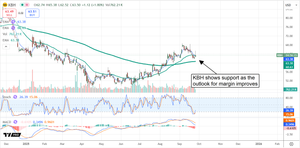
Tether (USDT), the issuer of the world's largest stablecoin, is reportedly on the cusp of a monumental financial maneuver, seeking to raise between $15 billion and $20 billion through a private placement. This ambitious fundraising round could catapult the company's valuation to an astonishing $500 billion, placing it firmly among the globe's most valuable private entities. This development, as of September 24, 2025, signals a profound strategic pivot for Tether (USDT), aiming to expand its influence far beyond its dominant position in the stablecoin market and into a diverse array of high-growth sectors.
The proposed private placement has sent ripples across the financial world, prompting intense speculation about the implications for the stablecoin ecosystem and the broader cryptocurrency landscape. A successful raise of this magnitude would not only underscore a burgeoning institutional confidence in digital assets but also equip Tether (USDT) with an unparalleled war chest, potentially reshaping competitive dynamics and accelerating its diversification into new technological frontiers.
A New Era for Stablecoins: Tether's Ambitious Expansion
Tether's (USDT) audacious plan involves selling approximately a 3% equity stake to a select consortium of "high-profile key investors." Wall Street powerhouse Cantor Fitzgerald, which reportedly already holds a 5% stake in Tether (USDT), is advising the stablecoin giant on this potentially transformative deal. While the target raise is ambitious, sources close to the discussions suggest the final figures could be adjusted, with the talks still in their preliminary stages and terms subject to change. The company aims to finalize the deal by the end of 2025, issuing new equity rather than facilitating existing shareholder exits.
Tether (USDT) CEO Paolo Ardoino has openly confirmed these discussions, articulating the company's intent to "maximize the scale of the Company's strategy across all existing and new business lines." These new ventures are remarkably diverse, spanning artificial intelligence (AI) development, commodity trading, energy infrastructure, communications, and media. This signals a clear strategic intent to evolve from a crypto-native stablecoin issuer into a multifaceted technology and financial conglomerate. The company has also been strategically bolstering its leadership, recently appointing Benjamin Habbel as Chief Business Officer to spearhead growth and portfolio expansion, further solidifying its aggressive expansion roadmap.
The sheer scale of a potential $500 billion valuation places Tether (USDT) in an elite league, alongside private tech behemoths such as OpenAI, SpaceX, and ByteDance. This valuation would not only validate the immense perceived value within the digital asset space but also fundamentally alter how stablecoins are viewed—transitioning from mere transactional utilities to potentially highly investable assets. The capital injection would provide Tether (USDT) with unprecedented resources to pursue its diversification strategy, potentially accelerating innovation within the broader crypto ecosystem while simultaneously raising questions about market centralization.
Who Stands to Gain or Lose?
A successful private placement of this magnitude would undoubtedly create clear winners and losers within the financial and crypto markets. Foremost among the winners would be Tether (USDT) itself and its existing shareholders. Cantor Fitzgerald, for instance, which reportedly holds a 5% equity stake, could see the value of its investment soar to approximately $25 billion if the $500 billion valuation materializes. New investors participating in the private placement would also gain a significant foothold in what could become one of the world's most valuable private companies, anticipating substantial long-term returns. Beyond direct stakeholders, the broader cryptocurrency market could also benefit, as such a high-profile institutional investment could significantly boost confidence among traditional financial players, potentially driving increased liquidity and demand for major cryptocurrencies like Bitcoin (BTC) and Ethereum (ETH).
Conversely, the move presents significant challenges for competitor stablecoin issuers, most notably Circle, the company behind USDC. With Tether's (USDT) current market capitalization for its stablecoin hovering around $172 billion, dominating over half of the total stablecoin market, and Circle's (USDC) considerably smaller valuation (reportedly between $30-$74 billion), this capital infusion could further widen the gap. Tether's (USDT) expanded war chest would enable more aggressive market strategies, potentially making it harder for rivals to compete on innovation, market reach, or strategic investments. This could lead to a more centralized stablecoin market, raising concerns about systemic risk and competition.
However, Tether (USDT) itself faces potential challenges. The massive scale of the raise and its potential valuation are likely to reignite long-standing questions regarding the company's transparency, reserve attestations, and overall governance, issues that have historically drawn scrutiny. Furthermore, while Tether (USDT) reported a robust Q2 2025 net profit of $4.9 billion, largely driven by interest income from its substantial reserves in U.S. Treasuries, the prospect of declining global interest rates could pose a risk to future earnings, impacting its profitability and the attractiveness of its business model in the long run.
Broader Implications and Regulatory Scrutiny
This proposed $20 billion private placement and the ensuing $500 billion valuation for Tether (USDT) signify a pivotal moment that transcends the immediate financial transaction, reflecting broader industry trends and carrying profound implications. It underscores the accelerating convergence of traditional finance with the digital asset space, as institutional capital increasingly seeks exposure to established, albeit private, crypto giants. The aggressive diversification strategy into AI, energy, commodities, communications, and media positions Tether (USDT) not merely as a stablecoin provider but as a burgeoning tech conglomerate, challenging the traditional definitions of financial companies. This move could inspire other crypto firms to explore similar diversification and fundraising avenues, seeking to capitalize on their brand recognition and capital generation capabilities.
The ripple effects on competitors, particularly in the stablecoin market, are substantial. A significantly strengthened Tether (USDT) could intensify competitive pressures on rivals like Circle (USDC), potentially forcing them to innovate more rapidly, seek their own substantial capital raises, or explore strategic partnerships to maintain relevance. This could lead to a stablecoin landscape dominated by a few well-capitalized players, potentially impacting smaller, emerging stablecoin projects. Beyond stablecoins, the institutional validation implied by such a valuation could encourage further mainstream adoption of cryptocurrencies, potentially driving more capital into the broader crypto ecosystem.
From a regulatory standpoint, a $500 billion valuation would undoubtedly elevate Tether (USDT) to a "systemically important" entity in the eyes of global regulators. This would trigger intense scrutiny, particularly concerning financial stability and consumer protection. The U.S. has already enacted the GENIUS Act in July 2025, mandating full reserve backing, monthly disclosures, and mandatory audits for stablecoins—a stricter framework than Tether's (USDT) current quarterly attestations. Similarly, Europe's Markets in Crypto-Assets (MiCA) regulation imposes stringent requirements, which Tether (USDT) has reportedly chosen not to fully comply with for the EU market. Tether's (USDT) efforts to launch a U.S.-compliant stablecoin and engage former White House officials indicate a proactive, albeit complex, strategy to navigate these evolving regulatory landscapes and capitalize on potentially more favorable environments. This event could accelerate global regulatory harmonization efforts as authorities grapple with managing the risks posed by such large, interconnected digital asset entities.
The Road Ahead: What Comes Next?
In the short term, the market will be keenly watching for the successful closure of Tether's (USDT) private placement by the end of 2025. Confirmation of the $15-$20 billion raise and the final valuation will dictate immediate market sentiment and set the stage for Tether's (USDT) strategic execution. The immediate deployment of this capital into its stated diversification initiatives—AI, energy, commodities, communications, and media—will be a critical indicator of its operational capabilities and commitment to its new vision. Competitors will likely be forced to reassess their own strategies, potentially leading to a flurry of M&A activity, new product launches, or defensive maneuvers within the stablecoin and broader crypto sectors.
Looking further ahead, the long-term possibilities are vast. Should Tether (USDT) successfully execute its diversification strategy, it could evolve into a dominant global technology and financial powerhouse, akin to a decentralized conglomerate. This could lead to the creation of new market opportunities in various sectors, where its stablecoin infrastructure could be leveraged for real-world applications. However, significant challenges remain, primarily navigating the ever-tightening global regulatory environment and maintaining investor confidence amidst intense competition and potential market volatility. The success of its AI, energy, and media ventures will be crucial, demonstrating whether its stablecoin-derived profitability can be effectively translated into sustainable growth across disparate industries.
Potential scenarios range from Tether (USDT) cementing its status as an indispensable global financial utility and tech innovator, to facing significant regulatory roadblocks that hinder its expansion. Its ability to manage transparency concerns and adapt to evolving compliance requirements will be paramount. Investors should monitor the progress of the private placement, the specific allocation of funds, and any further regulatory pronouncements. The success or failure of this audacious move will undoubtedly have a lasting impact on the trajectory of the stablecoin market and the broader integration of digital assets into the global economy.
A Defining Moment for Digital Finance
Tether's (USDT) proposed $20 billion private placement, eyeing a staggering $500 billion valuation, marks a defining moment for the stablecoin issuer and the wider crypto industry. This strategic move signals a bold ambition to transcend its stablecoin origins and establish itself as a diversified technology and financial leader across multiple high-growth sectors, including AI, energy, and media. The sheer scale of this potential capital infusion underscores a growing institutional appetite for established digital asset entities and promises to reshape competitive dynamics within the stablecoin market, potentially increasing centralization while also spurring innovation.
Moving forward, the market will closely scrutinize the successful completion of this private placement and Tether's (USDT) subsequent execution of its diversification strategy. While the potential for unprecedented growth and market influence is immense, the company faces significant hurdles, particularly navigating an increasingly complex global regulatory landscape and addressing long-standing transparency concerns. The success of this endeavor will hinge on its ability to effectively deploy capital, maintain regulatory compliance, and sustain investor confidence.
Investors should pay close attention to the unfolding developments surrounding this private placement, the specific details of Tether's (USDT) investments in new business lines, and any further regulatory actions from major global jurisdictions. This event has the potential to fundamentally alter the perception and role of stablecoins in the global financial system, solidifying their position as not just transactional tools but as cornerstones of a new digital economy. The coming months will be crucial in determining the lasting impact of Tether's (USDT) audacious leap.
This content is intended for informational purposes only and is not financial advice





